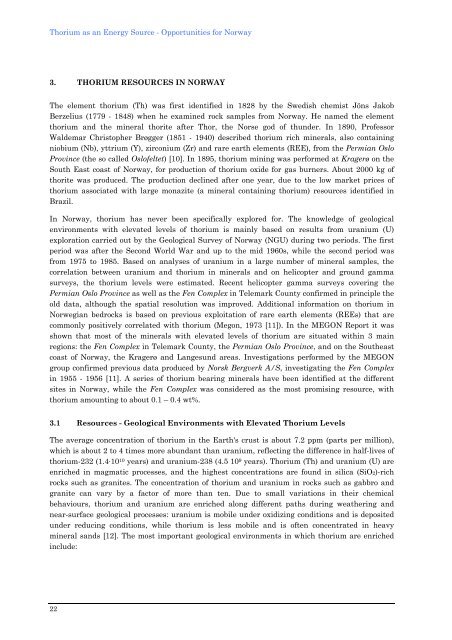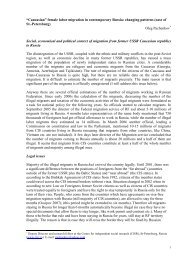THORIUM AS AN ENERGY SOURCE - Opportunities for Norway ...
THORIUM AS AN ENERGY SOURCE - Opportunities for Norway ...
THORIUM AS AN ENERGY SOURCE - Opportunities for Norway ...
Create successful ePaper yourself
Turn your PDF publications into a flip-book with our unique Google optimized e-Paper software.
Thorium as an Energy Source - <strong>Opportunities</strong> <strong>for</strong> <strong>Norway</strong><br />
3. <strong>THORIUM</strong> RE<strong>SOURCE</strong>S IN NORWAY<br />
The element thorium (Th) was first identified in 1828 by the Swedish chemist Jöns Jakob<br />
Berzelius (1779 - 1848) when he examined rock samples from <strong>Norway</strong>. He named the element<br />
thorium and the mineral thorite after Thor, the Norse god of thunder. In 1890, Professor<br />
Waldemar Christopher Brøgger (1851 - 1940) described thorium rich minerals, also containing<br />
niobium (Nb), yttrium (Y), zirconium (Zr) and rare earth elements (REE), from the Permian Oslo<br />
Province (the so called Oslofeltet) [10]. In 1895, thorium mining was per<strong>for</strong>med at Kragerø on the<br />
South East coast of <strong>Norway</strong>, <strong>for</strong> production of thorium oxide <strong>for</strong> gas burners. About 2000 kg of<br />
thorite was produced. The production declined after one year, due to the low market prices of<br />
thorium associated with large monazite (a mineral containing thorium) resources identified in<br />
Brazil.<br />
In <strong>Norway</strong>, thorium has never been specifically explored <strong>for</strong>. The knowledge of geological<br />
environments with elevated levels of thorium is mainly based on results from uranium (U)<br />
exploration carried out by the Geological Survey of <strong>Norway</strong> (NGU) during two periods. The first<br />
period was after the Second World War and up to the mid 1960s, while the second period was<br />
from 1975 to 1985. Based on analyses of uranium in a large number of mineral samples, the<br />
correlation between uranium and thorium in minerals and on helicopter and ground gamma<br />
surveys, the thorium levels were estimated. Recent helicopter gamma surveys covering the<br />
Permian Oslo Province as well as the Fen Complex in Telemark County confirmed in principle the<br />
old data, although the spatial resolution was improved. Additional in<strong>for</strong>mation on thorium in<br />
Norwegian bedrocks is based on previous exploitation of rare earth elements (REEs) that are<br />
commonly positively correlated with thorium (Megon, 1973 [11]). In the MEGON Report it was<br />
shown that most of the minerals with elevated levels of thorium are situated within 3 main<br />
regions: the Fen Complex in Telemark County, the Permian Oslo Province, and on the Southeast<br />
coast of <strong>Norway</strong>, the Kragerø and Langesund areas. Investigations per<strong>for</strong>med by the MEGON<br />
group confirmed previous data produced by Norsk Bergverk A/S, investigating the Fen Complex<br />
in 1955 - 1956 [11]. A series of thorium bearing minerals have been identified at the different<br />
sites in <strong>Norway</strong>, while the Fen Complex was considered as the most promising resource, with<br />
thorium amounting to about 0.1 – 0.4 wt%.<br />
3.1 Resources - Geological Environments with Elevated Thorium Levels<br />
The average concentration of thorium in the Earth's crust is about 7.2 ppm (parts per million),<br />
which is about 2 to 4 times more abundant than uranium, reflecting the difference in half-lives of<br />
thorium-232 (1.4·10 10 years) and uranium-238 (4.5 10 9 years). Thorium (Th) and uranium (U) are<br />
enriched in magmatic processes, and the highest concentrations are found in silica (SiO2)-rich<br />
rocks such as granites. The concentration of thorium and uranium in rocks such as gabbro and<br />
granite can vary by a factor of more than ten. Due to small variations in their chemical<br />
behaviours, thorium and uranium are enriched along different paths during weathering and<br />
near-surface geological processes: uranium is mobile under oxidizing conditions and is deposited<br />
under reducing conditions, while thorium is less mobile and is often concentrated in heavy<br />
mineral sands [12]. The most important geological environments in which thorium are enriched<br />
include:<br />
22

















